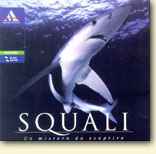|
Journal
of the twentyfirst day on board
23rd May, 1999
From today I'm receiving
questions about this "mamma shark" from the Gulf of
Taranto.
The situation I told is out of the ordinary, but not that much.
I don't want to transmit to those reading the anthropomorphic
idea of a small shark family swimming cheerfully in the middle
of the sea.
The shark does not look after her offspring, does not suckle
them, does not teach them, does not protect them.
As a result, for many types of shark their first enemy is their
mother.
Big sharks eat little sharks, whether they are family or not.
So nature has invented a strategy to help the mother from devouring
her children and sending the species into extinction: it has
removed its appetite during period of birth, avoiding, therefore,
any "errors".
This appetite
remains, however, unchanged in male sharks and for this reason,
in general, the females reproduce where there are no male sharks
in the so-called "nursery".
Having encountered
a very small 'verdesca' it made me think that the birth had
happened nearby. It was probably the case. So, a nursery for
'verdesche' in the Gulf of Taranto? Perhaps. It is known that
in many parts of the Mediterranean, for example in the upper
Adriatic, the 'verdesche' do reproduce. But in the Gulf of Taranto
are births fortuitous? Or is the Gulf of Taranto another nursery
for the 'verdesche'?
It
is too early to say. It's up to the researchers to prove it.

|

Taken
from the CD "Squali" of P. and
A. Angela
and A.L. Recchi
|
 |
